
PuzzleMaze - Wiz War
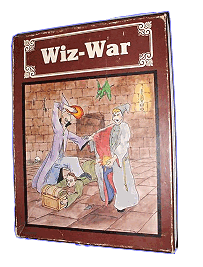
|
Wiz-War Original c 1985 |
Of course, the above doesn't really describe the game for newbies. But, this page really isn't for Wiz-War newbies, but for fans of the "Classic Edition".
I've been playing Wiz-War for over 25 years, and I think of it in terms of 3 editions: what I'll call the "Original Edition", from the 80s, which had two expansion sets, the "Classic Edition", from 1993, which had one expansion set, and the "Modern Edition", released in 2012, which will no doubt have many expansion sets. (Note that the above is from memory; I could be wrong, and I guess I could Wiki it, but I don't feel like it right now).
I started playing the Original Edition way back in the 80s, when I was in a small gaming club (the "DAM Gamers" from Audubon, PA, anyone still out there?). When it came time to buy my own set, the Original Edition was out of print, replaced by the Classic Edition. I've been playing that continuously since 1993. It has less cards than the Original Edition (both as expanded), but it has plenty.
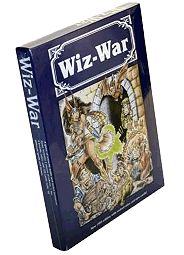
|
Wiz-War Classic c 1993 |
When the Modern Edition came out in 2012, I was disappointed. While there is alot to like about the Modern Edition, in particular, the artwork on the cards, some minor rule changes, and some refactoring of the rules (tho if I were in charge, my refactoring would be more extensive, yet it might take away from the original charm, so I prolly would be loathe to do it), there were some negatives that were difficult to overcome.
I won't go into too much detail on the negatives, suffice it to say that the changes made it a materially different game to what I'd been used to playing for 25 years. The main ones are that the ratio of NUMBER cards to other cards is way whacked as compared to previous editions, making movement more difficult, cluttery and weird cards have been eliminated in an effort to make the game more combative rather than game state manipulative, and, the dearth of NUMBER cards, coupled with the ability to use certain cards as low NUMBER cards, provides incentives to not use those cards (except as number cards), and I think the game is more fun when a great variety of cards is used. So, you have less diversity in cards than the previous edition, and incentive not to use the ones you have.
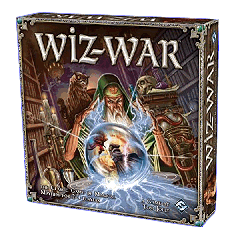
|
Wiz-War Modern c 2012 |
I could write a whole essay on the changes, but I won't. Maybe sometimes it just comes down to people hating change, and enjoying what they are used to.
Be that as it may, I decided I wanted a way to keep the Classic Edition alive, with all its cool cards that were eliminated in the Modern Edition, its charm, its "Jollyisms", its weird, bizarre, and unpredictable card interactions, combinations and debates, all of which seemed lost in the Modern Edition, yet suck in new cards from the Modern Edition and keep the game fresh as it continued to be expanded. Moreover, while I was at it, have a way to add my own cards in the spirit and proper mix of the original games.
So, that's what I decided to do, and that is what this page is about. If you are a fan of the Classic Edition as well, I hope you find it useful.
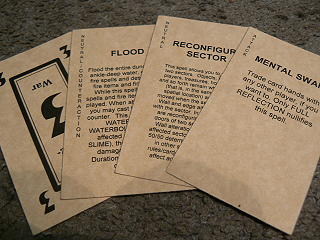
|
Same with keeping the ratio of attacks to counteractions to the rest of the cards, cards used for mobility and clutter, and so forth. The Modern Edition seemed to take out most attacks of a pain in the ass nature in favor of point-based attacks only (e.g., NO SPELL, IDIOT, MEDUSA), and these cards can be interesting and fun, so not only did I want to retain them, I wanted to retain the frequency of this class of card in the game going forward. Same goes for all classes.
Anyway, I took the Classic Edition (with the first expansion), and broke down the cards into various categories, and determined their frequencies, as summarized following --
| Card Type | Total | %Total | Example |
| NUMBER | 49 | 25% | average of about 3.286 |
| Attack (points) | 22 | 11% | FIREBALL |
| Attack (PITA) | 21 | 11% | NO SPELL |
| Attack (total) | 43 | 22% | |
| Counteraction (major) | 6 | 3% | FULL REFLECTION |
| Counteraction (minor) | 11 | 5.5% | BLUNT |
| Counteraction (total) | 17 | 8.5% | |
| Mobility/Clutter (PITA) | 19 | 10% | THORNBUSH, CREATE WALL |
| Mobility/Clutter (enabling) | 12 | 6% | PICK LOCK, DISPEL CREATION |
| Sector | 3 | 1.5% | ROTATE SECTOR, REDIRECTION |
| Mobility/Clutter (total) | 34 | 17% | |
| Special (normal, often enabling) | 11 | 5.5% | PASS THRU WALL, MIST BODY |
| Special (manipulative) | 6 | 3% | HEAVE HO, SAFE, TRADER |
| Special (total) | 17 | 8.5% | |
| Architectural (modifier) | 9 | 4.5% | ADD, EXTEND, AMPLIFY |
| Architectural (out of band) | 10 | 5% | INTERRUPT, REUSE SPELL, ANTI ANTI |
| Architectural (weird) | 3 | 1.5% | ALTER EGO, DEMOCRATIC MONSTER |
| Architectural (total) | 22 | 11% | |
| Other: Monsters | 4 | 2% | WRAITH |
| Other: Wands | 3 | 1.5% | SHIFT WAND |
| Stones | 8 | 4% | BRAINSTONE |
How could anyone be so geeky, and what did you do with this data? Well, I like the game, and wanted to keep the same feel while adding new cards. This data became guidelines for adding new cards. It led to the following rules for adding new cards.
Of course, I made it even more complicated, setting up cycles of tranches for things that did not span 24, but this is already too much, isn't it? The bottom line is that I was satisfied with the result of this approach in actual play, so I figured I'd document it for future reference. And, of course, it is only a guideline -- if I had a card I liked, I threw it in anyway, but this approach also served another purpose, to spur me to think of various cards in the different categories.
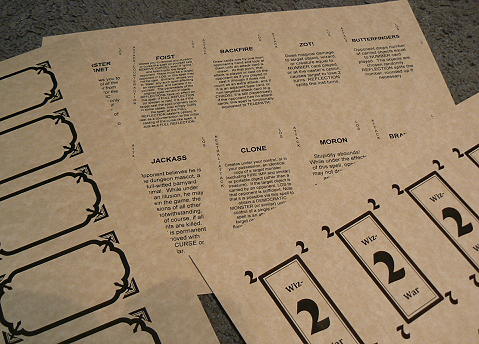
|
The most tedious part of this project was making my own cards, but successfully completing it was the most rewarding, as now I don't have to worry about my cards wearing out (which they were after over 20 years), and I can always add any card I want when I want to. Moreover, my set did not come with RELOCATE SECTOR (a must have, which has been inexplicably left out of the Modern Edition), or REMOVE CURSE. Now I have them. Most importantly, it was a fun total family project.
Here's how I did it. I used business card stock, Microsoft Word 2010, a color inkjet printer, slave labor, and plenty of trial and error. I like the way it turned out, tho I have some concerns about the long-term durability of the stock (my wife claims it is sturdier than the Classic Edition Stock, maybe, maybe not; it certainly is not as sturdy as the stock in the Modern Edition).
For stock, I used Aged Parchment Business Card Stock, #B308 from Rainbowkits.com LLC. This is a 65# stock. As these things go, it is wimpier than a 100# weight stock, which I also experimented with. The problem was, it was impossible, at least for me, to find a 100# business card stock with the cool aged parchment (or any design) look. So, it was a trade off between a cooler look, and more durability. I voted for the latter, but my family out-voted me. I bought a few packages of this stuff, just in case the place goes out of business.
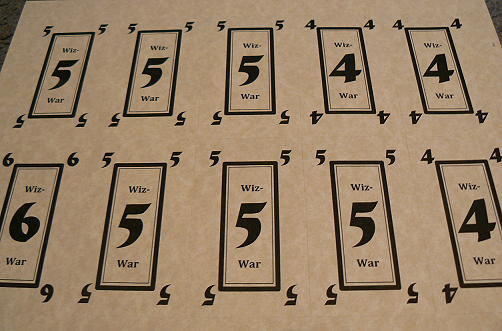
|
For layout, I used Microsoft Word 2010. You can fit 10 cards per sheet of stock. Word has the tools to do the backs, all the sideways printing, etc., if you know how to use it. I don't (in fact, I rarely use Word unless forced to), but my son is a whiz at it, and he pretty much did all the layout. He was brilliant; I could have never figured all that out. We used an arial font, point size 7 to 10, depending on how much copy was on the card (I had a rule that I would not go below 7pt; if it did not fit, we reworded cards (just the ones we wrote). My wife enjoyed helping with that part, but those who know me know I'm picky about wording when in the mood to be, and Wiz-War is one of those games where it matters). Then, lots of trial and error on the printer.
(Of course, all that copy from the Classic Edition cards had to be typed in by hand. I did most of that. I didn't mind; but it is certainly a tedious part of the project). One rule I had was to not change any of the wording of those cards, even where it is merited (as it is on many, if not most of them). The campy wording is part of the charm of the game. I did, however, break that rule a bit, fixing a couple of typos, and adding clarifications based on our house rules. A total of 6 cards were affected, and REVERSE needs to be updated to work with the new cards from the Modern Edition (more on that later, if I remember)).
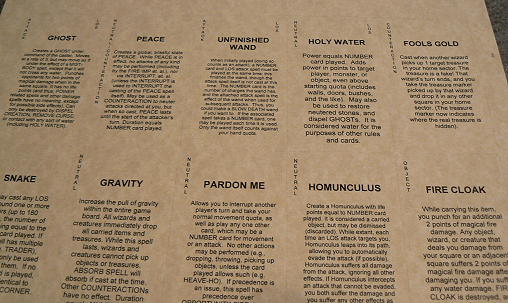
|
For the printer, I used an HP Officejet 6500A. I carefully documented how I fed the sheets in (flush left and so forth), printed little guide words on the front so I wouldn't have to think about which direction to feed the sheets for the backs, and so forth. Very important for a project like this, especially for the backs, as you don't want any inconsistencies. I was very happy with the results. I believe I blew thru 2 or 3 ink cartridges.
(As and aside, I would NOT recommend the 6500A in general, despite the fact that it worked well for this project. I hate the printer in all respects; it is just a lemon. But, the print quality works for a project of this nature if you are willing to put up with such a frustrating printer to use. Problem is, I'm now stuck with it, cause if I want to print cards again on a different printer, I will have to recalibrate everything. There is prolly a way to separate form from content using some sort of Word template or something (or at least there should be), as any intelligent person would seek to, but I didn't look into that. If you do this project, you should).
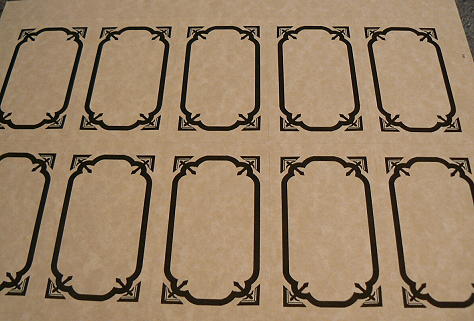
|
FWIW, expect to pay $100-$200 to do a project like this, between the stock and the ink cartridges, forgetting the time involved. Prolly better to just buy the Modern Edition. That's gains from specialization as an economist might say. This is only a project only for diehard fans. I wonder how many diehard fans of Classic Edition Wiz-War there are out there?
First, my intent was to take every new Tom Jolly card that I could get my hands on (unless it is ridiculous, e.g. THUMB OF GOD (and even in that case, we ported it); the only Jolly cards I've never used in any form is SWAP HOME BASES; maybe someday, and LIFESAVER (doesn't work in our house rules)), that's what diehard fans do. So, I went thru the Modern Edition cards, and brought in everything that was not in the Classic Edition.
The exceptions I made were as follows: I did not port BOOMSTONE; I didn't understand it, nor how it would fit rationally or uniquely into the Classic Edition framework (or even the Modern Edition framework, for that matter). Secondly, I had already written an analogue to NEGATE NEUTRAL (called VOICE OF GOD), which I preferred, and NEGATE NEUTRAL seemed to play to an element of of the Modern Edition architecture (which I otherwise like, BTW), that was inconsistent with the Classic Edition architecture, and besides, I felt my card was more fun. Finally, while I liked LIGHTNING BOLT, the Classic Edition already has a card called LIGHTNING BLAST, which I retained, so, at my wife's suggestion, I renamed LIGHTNING BOLT to THUNDER BOLT, and kept it. I like it, too bad the economics of either edition (but more so in the Modern Edition) will prevent its use most of the time (but that's fine, variable and situational usage is a big part of the fun).
Otherwise, the porting project pretty much amounted to adding Duration equals NUMBER card played to a boatload of new cards. Its clear that the NUMBER card architecture (at least in nomenclature), is being deprecated, and while such language isn't really necessary, its nice to be consistent.
The other issue in the Modern Edition architecture is the concept of Self affecting spells. This is not present in the Classic Edition architecture. It is implicitly present, in that most spells I classified as "special", earlier, are generally cast on oneself (e.g. MIST BODY, BIG MAN), but technically, as per the Classic Edition rules, it is legal to cast these sorts of spells on opponents as attacks. While it is rare to do so, it is sometimes necessary and desirable in terms of what we call the loser's game, so I did not want this Modern Edition restriction imposed on my Classic Edition games; if people want to cast these sorts of spells on someone else, for whatever reason, then they should be allowed to do so.
Thus, I ported these Self spells to LOS spells. This did have one unintended consequence (so far) -- STRETCH, a modern yet cool Jollyesque spell, was ported from Self to LOS, and it was interpreted that the STRETCHing could be performed within LOS (even if magically modified to wrap around corners and the like), while the intent was to port the casting of the ability to STRETCH to LOS, while the physical STRETCHing remained contained to the physical domain. (If you don't understand this paragraph, I'm surprised you have read this far :-)). The bottom line, STRETCH is a cool modern Jolly card that needs to be reworded to be ported to the Classic architecture.
Well, that's the big stuff, if you can call it big (as, IMHO), it is actually pretty minor, but there are a few more loose ends in the porting project. These may be interesting to Wiz-War geeks, or not, who knows?
First, is the concept, in the Modern architecture, of Objects. I like this concept. Problem is, what if the object sources an ATTACK, or NEUTRAL/COUNTERACTION effect? Problem continues -- the left sidebar offers only one slot for two inconsistent modalities. The real answer is another sidebar which introduces the modality of Spell vs Object. (If I were refactoring this thing, so many things I would do), but the real challenge is to remain true to the original, while incorporating the new, so, what I did in this case is port the new objects with an "object" modality on the sidebar, while retaining old modalities (e.g. ATTACK for DAGGER), on the old cards. Its inconsistent, but we'll figure it out.
Second, is the concept, in the Modern architecture, of Global spells. I like this concept as well. The only analogue in the Classic architecture is CHAOS. Thus, I made the decision to port new Global spells in the Modern Edition to work as CHAOS. A better approach, and an approach I will most likely implement, is to refactor this concept out, write a new Classic Edition house rule, and rewrite the CHAOS card and the relevant new Modern cards based on this refactoring. As an ex IT guy, I love the concept of refactoring cruft; as a passive fan of the Classic Edition cruft, I hate the idea. The tradeoffs we must make.
Finally, there is the REVERSE concept (I did remember after all). This came up in all the playtesting of this stuff, The Modern Edition offers the concept, for lack of a better word, of BACKLASH damage -- basically COUNTERACTIONS to spells which do damage to the attacker which cannot be evaded. (The concept of evasion is not in the Classic architecture, but I did not bother to port it, as such damage can be mitigated via BLUNT or ABSORB per the Classic rules). Except in the case of REVERSE. The card says damage from an "attack spell" or the like, where what we really want is "magical damage". This is a case of porting a Classic Edition card to make cards from the Modern Edition work, and that's what I'm gonna do (once I buy an another ink cartridge). Does that makes sense? Is anyone really reading all of this? I don't think so.
Note: One of the rules I placed on myself when writing my own cards was no changes to the Classic Edition rules or architecture; all new content had to be placed on the new cards. And, I was able to do that. But, in reconsidering this, I decided it was ok to refactor my own stuff. I'm not totally comfortable with the idea, and I guess what we have now is not pure Classic Edition Wiz-War, but it is still fun to play.
So, I added the following 2 new rules, which are used by a couple of my new cards.
So, that's that.EventsSome cards may specify the occurrence of something (e.g. IVY will creep), on a Common Event or Uncommon Event.
Events can occur when the die is rolled in the normal course of gameplay (e. g. when rolling to hit an INVISIBLE opponent, or when the TROLL rolls for damage). A Common Event will occur when an odd number is rolled, and a player points this out; an Uncommon Event will occur when a 4 is rolled, and a player points this out. Note that Events normally have no effect; they only have meaning if a card in play specifically says they do (e. g. IVY, BLACK HOLE).
The D4 should always be used in gameplay when a die roll is required, unless a larger die is necessary for the situation, in which case the smallest die that will handle the situation should be used (i. e., if there are 5 random possibilities, use a D6, rerolling sixes).
Events will not occur on rerolls. For example, if there are 3 possibilities, you would use the D4, rerolling fours. An event could occur if a 4 is rolled on the first roll, but not on any rerolls.
Events will not occur recursively. For example, if a card requires something to occur on an event, and handling that occurrence requires rolling the die, that rolling will not generate further events (e. g., IVY creeping to random edges).
Layered Edge Alterations
A Layered Edge Alteration sits on top of another edge feature such as a WALL or DOOR, rather than replacing it (thought it is possible these types of alterations could occupy an edge all by themselves, either because they were created in an empty edge, or because the underlying WALL was destroyed). It sits on ether one side or the other of the WALL, though two separate instances could sit on each side.
Unless otherwise specified, there is no LOS to the underlying WALL thru a Layered Edge Alteration, though a VISIONSTONE could see thru the first layer to the WALL, but not then thru the wall, unless there is a sort of stone or spell that allows seeing thru two obstacles. When passing thru or destroying edge features, each one must be dealt with separately, e. g., if IVY is covering the side of a WALL, a MIST BODY could get thru the IVY, then a PASS THRU WALL, DESTROY WALL (just as you are passing thru the IVY, and see the WALL), or DISPEL CREATION (assuming the WALL was a created WALL) could be used.
When damaging layered edge features, there is no damage carryover. E. g., a 10 point SUDDEN DEATH on a 7 point IVY would remove the IVY, but the underlying WALL would still have 20 points.
Second, thanks to my family for helping with, and putting up with this project, and to Chip for playtesting this stuff.
Finally, FWIW, here are our house rules, clarifications, and the results of endless debates of playing this game over the years. Its a Word doc (yuck!); I do have a TeX version somewhere tho -- that's how old this stuff is originally.